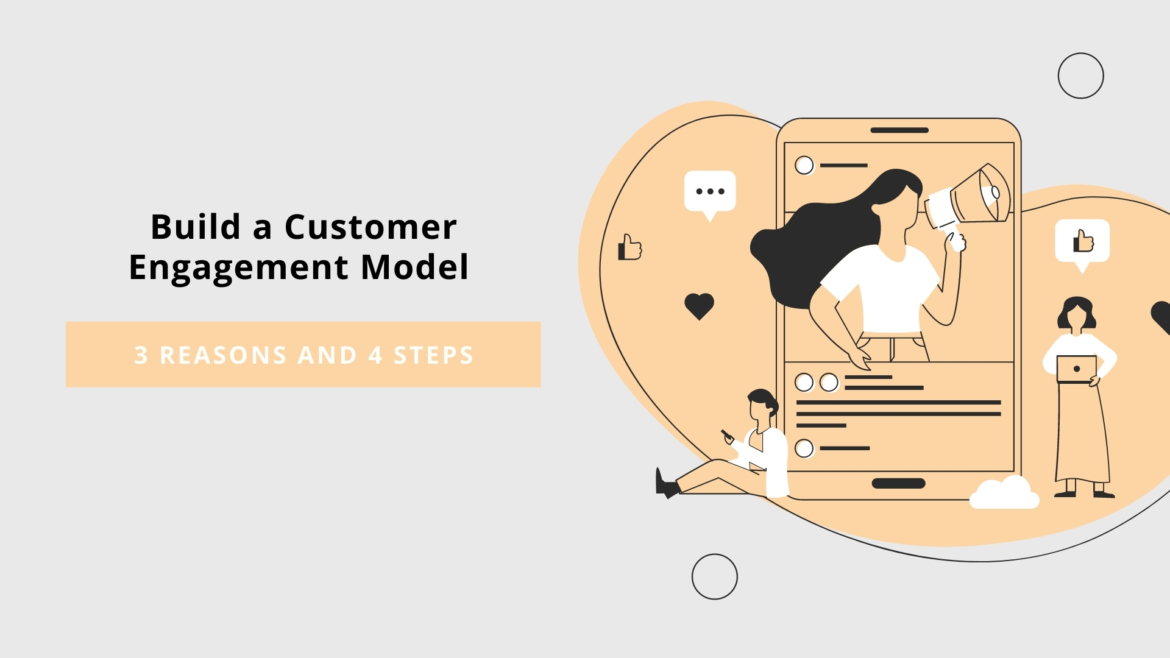In business, just as in one’s life, relationships are foundational to success. While an end goal for all businesses is to make money, that can only be achieved when customers buy products or hire from services. A clever advertisement with a catchy title and photo may initially draw them to your business, it is the relationships that businesses form with customers that help ensure lasting success. Customers are drawn to businesses brands that not only share similar values but ones that actively try to engage with them and improve their life in some way.
Customers that are engaged with your brand are more likely to be happier—and repeat—customers. The best way to achieve these relationships is by developing and implementing a customer engagement model.
Forming these relationships may, from the customer’s side, seem to happen almost organically, but in reality, there are people behind the scenes working diligently to make them happen. Teams of individuals will create, deploy, analyze, re-create, and re-deploy strategies as part of an overarching customer engagement strategy. But what exactly is consumer engagement and a customer engagement model? What are the steps in developing a customer engagement plant?

Here are three reasons to build a customer engagement model (with four steps to help you build your own).
Reason 1: Customers Are at Different Stages
Think about the person in your life with whom you are closest who is also not a member of your family. How did you meet them, and what was that initial meeting like? It could have been more formal, with a mediated introduction, such as in an office setting. Or you were in school and made to introduce yourself by answering an ice breaker. Now think of your relationship with that person after a few weeks and after six months. Now think about a full year. How did it progress and develop? Do you find that you are now more comfortable around them? Do you know their likes and dislikes? Could you order for them at a restaurant?
Consumer engagement develops relationships like people develop relationships with new friends: Things occur at different stages, and it is important that you know what these stages are to appropriately engage with the customer.
Stage 1: Reach/Unknown
In this stage of the relationship, the customer doesn’t know that your business exists. While all stages require diligence and effort, this stage is the precursor to all others: If you don’t get to this stage, then there is no way you can attempt to engage with the prospective customer. Once they are aware of your existence, they can move onto the next stage.
Stage 2: Discovery
The discovery stage is similar to a first date: Who are you? What do you value? What can you offer? In this stage, your prospective customers will start to learn about your company and its products or services—and you will learn about them as well. How did they find your website? What are their demographics? What pain points do they have that you can address? Knowing the answers to these questions will help you in Stage 3.
Stage 3: Consideration
This stage is the fork in the road: Does the prospective customer go to you or to another business? How can you convince them to choose you over others in the industry? They have a multitude of options, so your goal in this stage is to convince them that they only have one: You. Provide compelling content that proves that you are the only choice.
Stage 4: Conversion
In this stage, a prospective customer becomes a customer, since they completed a purchase—and chose you over another competitor. Show them your gratitude by sending a follow up message through a channel like email or text. If someone hasn’t quite completed the conversion yet—such as putting an item in their virtual cart and leaving it there without checking out—sending a follow up email, in an effort to complete the conversion. What reservations do they have?
Stage 5: Nurture
In this stage, your customer engagement strategy is crucial. Yes, the customer has converted and bought a product or service, requested a demo, or completed some other desirable action, but now you need to nurture the relationship you’ve established with them. You don’t want to make them feel slighted or ignored after you’ve gone through all that work to get your relationship with them to this stage.
Reason 2: Engaged Customers Promote
Another reason that you’ll want to focus on consumer engagement is because engaged customers will promote your company. Have you ever eaten at a restaurant and had an incredible meal, then later shared your experience with a family member or friend? The idea behind engagement strategies is similar: Customers that are engaged (i.e., happy with their experience with your brand) will share that with others. It is essentially free marketing for your business, and good free marketing at that: Recommendations from close family or friends are likely to influence a consumer to make a purchase.
Reason 3: Grow Revenue
There is a correlation between happy customers and a business’s profits. When a business focuses on their customer’s experience with their brand, they can see realized, increased profits. Customers want to feel heard, so when you show that you understand them (regardless of what stage they are at with your business), they are more inclined to choose you over competitors. All of that translates to more revenue for your business.
Develop Your Customer Engagement Strategy
A customer engagement plan will look different for each business, even those that are competitors in the same industry; however, there are some techniques you can incorporate to make sure you are developing engagement strategies that work.
Know that there are two facets to any customer engagement model: Onboard and Retain. In the Onboard portion of your model, you’re looking to acquire new customers, get more people aware of your business, and establish a strong brand. In Retain, you’ll want to keep the customers you’ve already acquired and get visitors to keep returning so they can go through the engagement stages.
Step 1: Define Your Customer Base
You have to know your customers to be able to successfully engage with them. Think about who your customers are: What are their pain points, and how can your product or service meet their needs? How can you engage with them to show them that you understand and can address these needs? If they are just passively engaged (such as browsing), by engaging with them, you can significantly increase your conversion rates later.
Step 2: Identify Opportunities to Connect
There are various opportunities for customers to engage with you, from your website to social media platforms. You need to develop strategies for each of these interaction points because 1) you don’t want to miss out on an opportunity to engage and 2) each channel provides a different opportunity for interaction, and one strategy may not be appropriate for all channels. For example, if a customer leaves a question on an Instagram post, you’ll want to engage them by responding directly on the post; however, you can automate something similar on your website by implementing a chat bot that can answer a customer’s questions.
Step 3: Personalize
Consumers have come to expect a personalized experience, and the more you can personalize your engagement with them, the better. You’ll be able to target in on their specific needs, which means they are more likely to convert later in the buying journey. It also makes the experience much smoother: If a customer is shopping online but leaves, having the item remain in their cart offers convenience; product suggestions offer an additional helping hand for other needs they have but may not necessarily be looking into at the moment.
Step 4: Observe and Adapt
Your engagement strategies may miss the mark a few times, especially when you first create them. You need to give them time to work so that you can gather data on them. Once you have that data, you have a better picture of which ones work, which fall a little flat, and which are completely off base. Here are some aspects to consider when it comes to evaluating your strategies:
Offer Acceptance
Personalize offers for customers based on the stage of engagement they are in. With a customer who is in the conversion stage, you may want to offer a free trial. For those in the nurture stage, you can consider offering a discount. Set up these offers and see if they are accepted or rejected. What are the reasons for either? Do you need to modify the offer for it to be accepted?
Bounce Rates
Bounce rates are great at telling you where you’re losing the customer along the buying journey. On what webpages are they spending a lot of time and taking actions (such as clicking through to other webpages), and how can you mimic that success on web pages they are quickly leaving?
Survey Responses
You need to listen to your customers, whether that experience was good or bad. Sending out surveys can help you modify your efforts appropriately. For example, some websites will have a survey that asks about ease of using the website; if a website is difficult to use, you’ll see a high bounce rate or lower conversions. If someone made a purchase, you’ll want to send an acknowledgement message thanking them and immediately asking about their purchasing experience. Negative feedback can have even more value than positive feedback, because it lets you know where you failed to resonate with a customer.
Implement a Customer Engagement Model for Continued Success
With so many options on the market, you need to make sure that your business and brand stand out in the eyes of prospective customers. Two businesses may have a product or service equal in every way, but it is the business that can engage well and create strong relationships with customers that will ultimately win the customers’ business.


